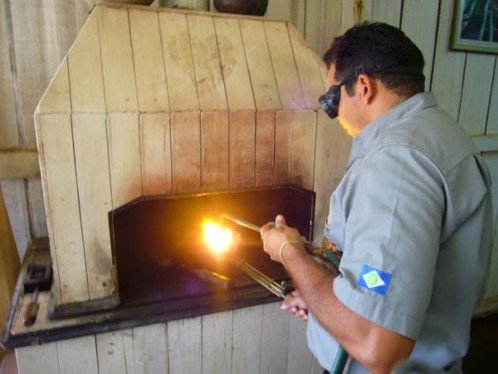Reducing Mercury Pollution from Artisanal and Small-Scale Gold Mining
Mercury has long been used in artisanal and small-scale gold mining (ASGM) to extract gold from ore sediment and rock deposits. ASGM accounts for more than a third (38%) of all anthropogenic mercury emissions to the atmosphere, with most ASGM sector-related mercury emissions coming from the burning of mercury-gold amalgam. Around the world, tens of millions of workers engage in the ASGM sector, producing up to 20% of the world’s gold annually. Gold from the ASGM sector is sold into global supply chains to satisfy demand for jewelry, investment purposes, central bank reserves, and technology/electronics.
- More information on Health Effects of Exposures to Mercury.
- Learn more about International Actions for Reducing Mercury Emissions and Use.
A Focus on Gold Shops
Mercury Capture Systems: A Technical Project Summary
From 2005-2010, EPA led efforts in collaboration with U.S. Department of Energy’s Argonne National Laboratory (ANL) to develop a system capable of capturing mercury at the emission source to reduce gold shop-related emissions from amalgam burning as a near-term option for reducing ASGM emissions. The resulting Mercury Capture System (MCS) was designed to provide a simple system that is highly effective in capturing mercury, and inexpensive and easy to construct using locally available materials.
EPA and ANL developed a technical project report as a follow-up to the project to raise awareness of gold shops as key sources of ASGM sector mercury emissions, share details of the US EPA/ANL Mercury Capture System project, and present other mercury capture options for gold shops. The project report provides:
• An overview of the role for gold shops within the ASGM sector;
• Findings on the presence and exposure to mercury emissions from existing gold shop practices;
• A description of Mercury Capture System components, the construction process, and benefits from its implementation; and
• An assessment tool to assist researchers in gathering data to determine uptake challenges and effectiveness of mercury capture technologies.

The report concludes that while complete elimination of mercury from the ASGM process is a desirable goal, in the near-term significant emissions reductions can be achieved if mercury is captured during amalgam burns. By limiting the path of mercury release into the environment, the captured mercury can instead be redirected for re-use or appropriate storage and eventual disposal.
Information presented in this report can be useful for countries developing Minamata Convention ASGM National Action Plans (NAPs) and organizations implementing local and regional projects as they consider and evaluate the adoption of mercury capture technologies as an effective means of reducing local and global emissions of mercury stemming from the ASGM sector.
Contact
For more information and to receive a copy of the technical project report, please contact:
